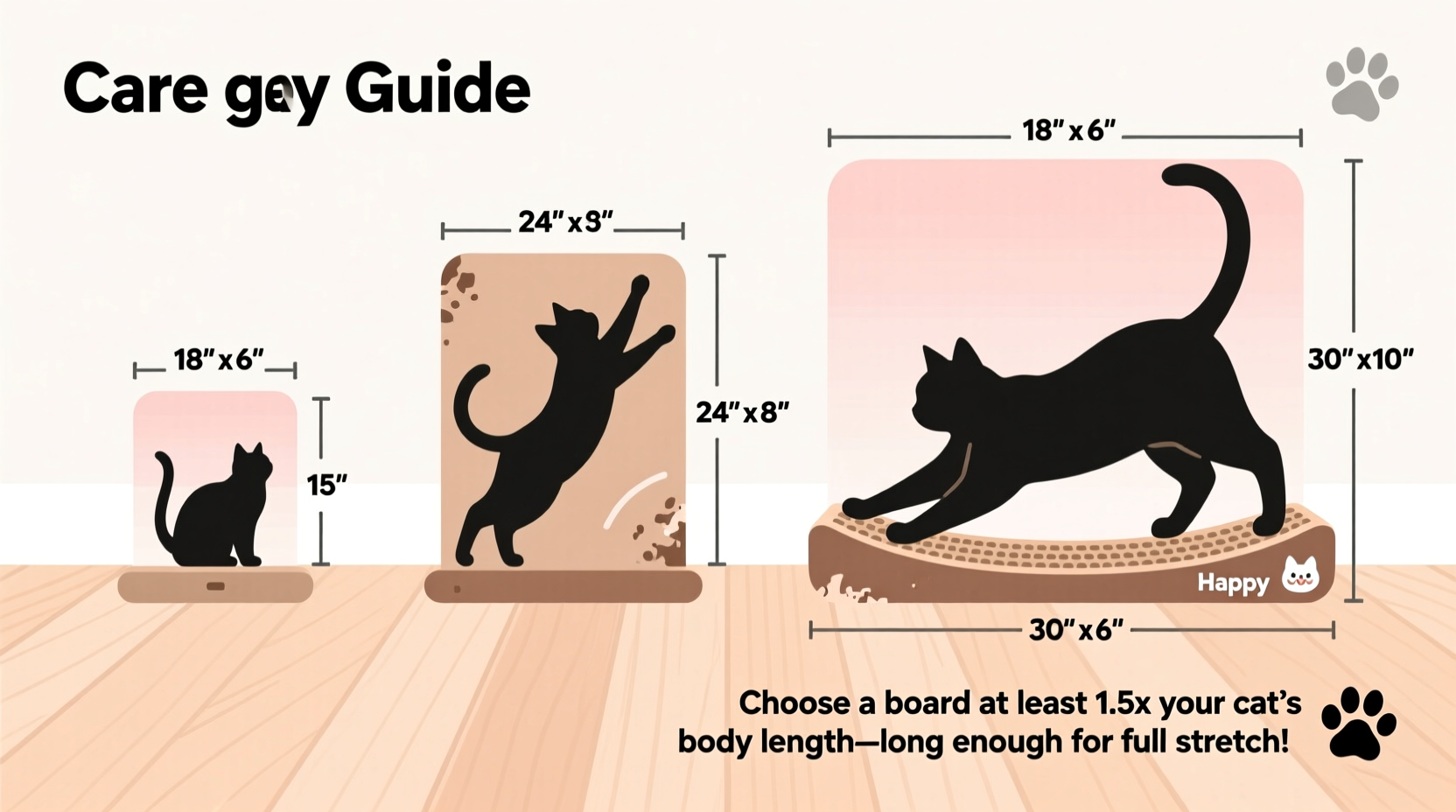Cats scratch for instinctual reasons—marking territory, stretching muscles, shedding claw sheaths, and relieving stress. When they don’t have an appropriate outlet, sofas, carpets, and baseboards often pay the price. A well-chosen scratching board can redirect this natural behavior effectively—but only if it’s the right size. Too small, and your cat won’t use it; too large, and it becomes a space-hogging eyesore. The key is matching the board to your cat’s physical needs, behavioral patterns, and your living environment.
Understand Your Cat’s Scratching Behavior

Before selecting a scratching board, observe how your cat scratches. Some cats prefer vertical scratching, while others favor horizontal or angled surfaces. Most cats stretch fully when scratching, extending their front paws and sometimes their back legs. This full-body motion is crucial for joint health and muscle tone.
Pay attention to where your cat currently scratches. Is it the corner of the couch? The edge of the rug? These locations offer clues about preferred height, texture, and orientation. If your cat targets the side of furniture, a tall vertical board may be ideal. If they dig into floor mats, a flat or low-profile surface might work better.
“Scratching is not just about claw maintenance—it’s a vital part of feline physical and emotional well-being.” — Dr. Rebecca Tran, DVM, Feline Behavior Specialist
Key Factors in Selecting the Right Size
The ideal scratching board isn’t one-size-fits-all. Multiple factors influence what will work best for your cat and home.
1. Your Cat’s Body Length and Weight
A scratching board should allow your cat to stretch to full extension without feeling cramped. Measure your cat from nose to tail base while standing. Then, observe how far their front paws reach when stretching upward. As a rule:
- Cats under 8 lbs: Minimum 16” height (vertical), 18” length (horizontal)
- Medium cats (8–12 lbs): 18–24” height, 20–24” length
- Larger cats (12+ lbs): 24–30” height, 24–30” length
2. Available Space in Your Home
Even the perfect board is useless if it doesn’t fit comfortably in your space. Measure the area where you plan to place the board—near a sofa, beside a bed, or in a quiet corner. Ensure there’s at least 6 inches of clearance on all sides for easy access.
3. Orientation Preference
Some cats prefer vertical scratching, especially for territorial marking. Others like horizontal boards for quick paw swipes. Consider getting both types or choosing a dual-surface model if space allows.
Size Comparison Guide for Common Scratching Boards
| Type | Ideal Dimensions | Best For | Limitations |
|---|---|---|---|
| Vertical Cardboard | 24” H x 16” W | Tall cats, wall-leaning placement | Can tip if not secured |
| Horizontal Scratcher | 20” L x 14” W | Kneading, lounging, multi-cat homes | Less effective for full stretches |
| Angled Scratcher | 22” L x 12” H (45° angle) | Balances stretch and accessibility | May take up floor space |
| Wall-Mounted Panel | 30” H x 18” W | Maximizing vertical space, modern homes | Requires installation |
Step-by-Step Guide to Choosing the Perfect Board
- Measure your cat: Note body length and maximum stretch height while standing.
- Identify current scratching zones: Observe which furniture or surfaces are targeted.
- Assess available floor or wall space: Choose a location with minimal foot traffic but high visibility to your cat.
- Select orientation: Match to your cat’s preference—vertical, horizontal, or angled.
- Pick dimensions: Use the size guidelines above as a starting point.
- Introduce gradually: Place the board nearby and encourage use with catnip or treats.
- Monitor and adjust: If unused after 7–10 days, reposition or try a different size or material.
Real Example: Solving Bella’s Sofa Problem
Bella, a 10-pound domestic shorthair, had been shredding the arm of her owner’s leather sofa for months. Her owners tried sprays and double-sided tape, but nothing worked. After observing Bella’s behavior, they noticed she always stretched upward before settling down. They measured her stretch at 22 inches and placed a 24-inch vertical cardboard scratcher against the wall beside the sofa. Within two days, Bella was using it regularly. By week three, the sofa was spared. The solution wasn’t punishment—it was providing a properly sized alternative in the right location.
Checklist: Before You Buy a Scratching Board
- ✅ Measured my cat’s full stretch height
- ✅ Identified where my cat likes to scratch
- ✅ Measured available space (floor or wall)
- ✅ Decided on orientation (vertical, horizontal, or angled)
- ✅ Checked product dimensions match my cat’s needs
- ✅ Verified stability (won’t tip over)
- ✅ Confirmed ease of replacement or refill (for cardboard types)
Frequently Asked Questions
How do I know if the scratching board is too small?
If your cat can’t extend their front legs fully while scratching, or if they avoid it altogether, the board is likely too small. Cats often turn away from boards that feel restrictive or unstable.
Can one scratching board work for multiple cats?
Only if it’s large enough and placed in a neutral zone. In multi-cat households, experts recommend one scratching station per cat, plus one extra. This prevents competition and ensures all cats feel safe using them.
How often should I replace a cardboard scratching board?
Inspect monthly. Replace when fibers are worn down, edges are frayed, or the board collapses under pressure. Frequent users may need replacements every 3–6 months.
Final Thoughts: Size Matters More Than You Think
Choosing the right scratching board size isn’t just about convenience—it’s about respecting your cat’s instincts and supporting their physical health. A properly sized board encourages full-body stretching, reduces destructive behavior, and enhances your cat’s sense of security in your home. Don’t settle for whatever fits on the shelf at the pet store. Take the time to measure, observe, and match the board to your cat’s unique needs.









 浙公网安备
33010002000092号
浙公网安备
33010002000092号 浙B2-20120091-4
浙B2-20120091-4
Comments
No comments yet. Why don't you start the discussion?